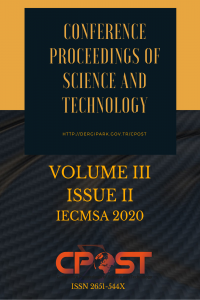Öz
Kaynakça
- 1 K. Atanassov, Intuitionistic fuzzy sets, Fuzzy Sets Syst., 20, (1986), 87–96.
- 2 Bolturk E, and Kahraman C. A novel interval-valued neutrosophic AHP with cosine similarity measure. Soft Comput 22, (2018), 4941–4958.
- 3 Esra Ilbahar, Ali Kara¸san, Selcuk Cebi, Cengiz Kahraman, A novel approach to risk assessment for occupational health and safety using Pythagorean fuzzy AHP & fuzzy inference system, Safety Science 103 (2018) 124–136. https://doi.org/10.1016/j.ssci.2017.10.025.
- 4 Madylova A, and Oguducu SG. A taxonomy based semantic similarity of documents using the cosine measure. 24th International Symposium on Computer and Information Sciences 129:34, 2009.
- 5 Peng X, Yang Y. Fundamental proporties of interval valued pythagorean fuzzy aggregation operators, Int J Intell Syst 2016;31(5):444–87.
- 6 Serap Tepe, ˙Ihsan Kaya (2020) A fuzzy-based risk assessment model for evaluations of hazards with a real-case study, Human and Ecological Risk Assessment: An International Journal, 26:2, 512-537, DOI: 10.1080/10807039.2018.1521262.
- 7 R. R. Yager, Pythagorean fuzzy subsets, In: Proc Joint IFSA World Congress and NAFIPS Annual M eeting, Edmonton, Canada; (2013), 57–61.
- 8 R. R. Yager, Pythagorean membership grades in multicriteria decision making IEEE Trans Fuzzy Syst., 22, (2014), 958–965.
- 9 R. R. Yager, A. M. Abbasov, Pythagorean membership grades, complex numbers, and decision makin, Int J Intell Syst. 28, (2013), 436–2.
Risk Assessment of Cognitive Development of Early Childhood Children in Quarantine Days: A New AHP Approach
Öz
The world is faced with disasters caused by natural or human effects from time to time. The various political, economic, health, and social consequences of these disasters affect people for different periods of time. In natural disasters and especially in epidemic diseases, some measures are taken to protect people from the negative effects of the situation. One of the measures that can be taken is quarantine. The target audience of this study is children aged 5-6 in the early childhood. Children of this age group are in the process of gaining skills in expressing their feelings during this period. In addition, the emotional responses of these children can be noticed by a careful observer or even an expert. The purpose of this study is to evaluate the risks of the effects of quarantine status related to COVID-19 pandemic on cognition and behavior of children staying at home. A new AHP technique was used to assess the risks of the quarantine process in early childhood children.
Anahtar Kelimeler
COVID-19 early childhood risk assessment Pythagorean fuzzy set analytic hierarchy process cognitive development behavioural development
Kaynakça
- 1 K. Atanassov, Intuitionistic fuzzy sets, Fuzzy Sets Syst., 20, (1986), 87–96.
- 2 Bolturk E, and Kahraman C. A novel interval-valued neutrosophic AHP with cosine similarity measure. Soft Comput 22, (2018), 4941–4958.
- 3 Esra Ilbahar, Ali Kara¸san, Selcuk Cebi, Cengiz Kahraman, A novel approach to risk assessment for occupational health and safety using Pythagorean fuzzy AHP & fuzzy inference system, Safety Science 103 (2018) 124–136. https://doi.org/10.1016/j.ssci.2017.10.025.
- 4 Madylova A, and Oguducu SG. A taxonomy based semantic similarity of documents using the cosine measure. 24th International Symposium on Computer and Information Sciences 129:34, 2009.
- 5 Peng X, Yang Y. Fundamental proporties of interval valued pythagorean fuzzy aggregation operators, Int J Intell Syst 2016;31(5):444–87.
- 6 Serap Tepe, ˙Ihsan Kaya (2020) A fuzzy-based risk assessment model for evaluations of hazards with a real-case study, Human and Ecological Risk Assessment: An International Journal, 26:2, 512-537, DOI: 10.1080/10807039.2018.1521262.
- 7 R. R. Yager, Pythagorean fuzzy subsets, In: Proc Joint IFSA World Congress and NAFIPS Annual M eeting, Edmonton, Canada; (2013), 57–61.
- 8 R. R. Yager, Pythagorean membership grades in multicriteria decision making IEEE Trans Fuzzy Syst., 22, (2014), 958–965.
- 9 R. R. Yager, A. M. Abbasov, Pythagorean membership grades, complex numbers, and decision makin, Int J Intell Syst. 28, (2013), 436–2.
Ayrıntılar
| Birincil Dil | İngilizce |
|---|---|
| Konular | Mühendislik |
| Bölüm | Articles |
| Yazarlar | |
| Yayımlanma Tarihi | 28 Aralık 2020 |
| Kabul Tarihi | 25 Aralık 2020 |
| Yayımlandığı Sayı | Yıl 2020 Cilt: 3 Sayı: 2 |


